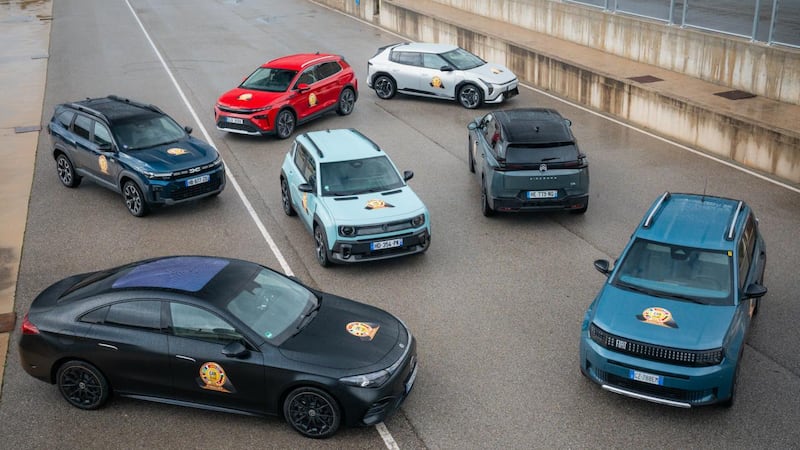The car industry looks to be on course to vastly exceed the CO2 emissions budget it has been given under the Paris Agreement to limit global heating to 1.5 degrees Celsius above pre-industrial levels.
Such declarations of climate doom and gloom about the world’s car makers are nothing new, but what is different here is that the accusations are being levelled by car makers against the wider industry. By two car makers, to be exact. Polestar – Volvo’s spin-off all-electric and high-performance brand – and Rivian, the US start-up that is troubling Tesla and which has brought its handsome R1T electric pickup truck to the market long before the vaunted Cybertruck has bothered a showroom floor.
The two electric car makers have combined to commission a report from global business consultancy Kearney on how the world’s car makers are getting on with their carbon budgets. The sad, and somewhat predictable, answer is badly.
The UN’s International Panel on Climate Change (IPCC) has said that greenhouse gas emissions need to be cut by 43 per cent come 2030 if we’re all to stay on track to meet our Paris Agreement commitments. According to Polestar, Rivian and Kearney, car makers – which are responsible for around 15 per cent of the world’s emissions – will miss that target by as much as 75 per cent.
RM Block
It gets worse. By 2050, the general plan is for the world as we know it to be at net carbon-zero, and car makers have been given a budget of CO2 to spend between now and then. The report reckons that they’ll have blown through that by 2035.
None of this makes especially comfortable reading, but the slightly better news is that it is not too late, and the globe’s car industry can still make the adjustments it needs to get back on track.
According to the Pathway Report issued by Kearney on behalf of Polestar and Rivian: “Despite the gloomy outlook, the report suggests that the car industry still has a chance to get on track. By redirecting resources and focus, the industry can rapidly build the momentum required to remain in line with the Paris Agreement. The Pathway Report focuses on the current decade and outlines immediate, clear actions that car manufacturers can take between now and 2030, including some that can be triggered immediately.”
Those actions are defined, in the report, by three “levers”.
Lever One is about switching over from internal combustion cars to electric models, something that Polestar and Rivian have already done and which the rest of the industry is rapidly doing as well. That alone will not be enough, though. “The speed at which fossil fuel-powered cars need to be replaced by electric cars alone will not be enough.
A lot more work will be required for levers Two and Three: “Increasing renewable energy in power grid and reducing greenhouse gas emissions in the manufacturing supply chain,” says the report.
“Pulling just one or two levers in isolation will be insufficient and only reduce the overshoot. Collective action from automakers is needed on all three levers, in parallel, at a global level.
“Firstly, the industry must accelerate the transition to electric vehicles by investing in manufacturing capabilities, as well as implementing a firm end-date for fossil fuel car sales globally. Secondly, build out renewable energy supply to global grids that enable EV’s to reach their full potential through green charging. Thirdly, decarbonise the manufacturing supply chains for these vehicles through switching to low carbon materials, and investing in renewable energy solutions for supply chains.”
[ Cop15: Deal secured to halt destruction of Earth’s ecosystemsOpens in new window ]
Fredrika Klarén, Polestar’s head of sustainability, said: “Car companies may be on different paths when it comes to brand, design, and business strategies, and some won’t even admit that the road to the future is electric. I believe it is, and that the climate crisis is a shared responsibility, and we must look beyond tailpipe emissions. This report makes clear the importance of acting now and together. There’s a clear cost to inaction, but there’s also a financial opportunity for innovators who find new answers to the challenges we face.”
Anisa Costa, Rivian’s chief sustainability officer, said: “The report’s findings are sobering. Our hope is that this report lays the groundwork for the automotive industry to collaborate in driving progress at the pace and scale we need – and ideally inspiring other industries to do the same. Together, I’m confident we can win the race against time.”
According to Kearney’s, the Pathway Report will be circulated to all of the world’s car makers in the hope that it will bring as many of them as possible together for a discussion on the matter. One thing the report makes very clear is that only collective action will bring results.
Angela Hultberg, global sustainability director at Kearney, said: “We are proud to have been chosen as a trusted expert to develop this report. The result of our modelling clearly shows that the industry needs to accelerate the pace of becoming a low carbon industry. We looked at different scenarios, different data points, and the conclusion is that no matter how you model it, we are far too close for comfort. We sincerely hope this report will be a starting point for the industry to focus on areas where there is agreement and find specific initiatives. It will take collective action to solve some of the issues at hand, and we look forward to seeing what the manufacturers will do in the near future.”
















